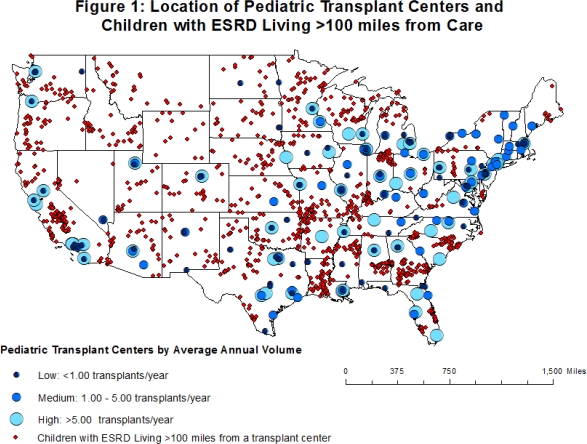Geographic Variability in Access to Transplant Centers for Children with End-Stage Renal Disease.
1Pediatrics, The Children's Hospital of Phila, Philadelphia, PA
2Biostatistics and Epidemiology, The University of Pennsylvania, Philadelphia, PA.
Meeting: 2016 American Transplant Congress
Abstract number: D163
Keywords: Kidney transplantation, Pediatric, Renal failure
Session Information
Session Name: Poster Session D: Kidney-Pediatrics
Session Type: Poster Session
Date: Tuesday, June 14, 2016
Session Time: 6:00pm-7:00pm
 Presentation Time: 6:00pm-7:00pm
Presentation Time: 6:00pm-7:00pm
Location: Halls C&D
Background: Kidney transplantation is the optimal treatment for pediatric end-stage renal disease (ESRD); yet, there is substantial variability in waiting times for deceased donor kidneys for children depending on where they live. Adult kidney transplant candidates living farther from transplant centers are less likely to receive a deceased donor transplant and have inferior post-transplant survival. From evaluation to surgery, the transplant process requires time and travel to a transplant center, which may present a substantial burden to individuals with limited social resources. Because pediatric kidney transplantation requires multi-disciplinary care and pediatric expertise, geographic access to transplant centers serving children is an area of concern. This retrospective study analyzes geographic variability in access to transplant care for children with end-stage renal disease, from 2000-2012.
Methods: Using ArcGIS, we geocoded the locations of children diagnosed with end-stage renal disease (ESRD) from 2000-2012 (n=12,379) by residential zip code and the locations of transplant centers transplanting at least one child from 2000-2012 (n=209). Geospatial access to transplant care was measured by the straight-line distance from patient zip code to the location of nearest transplant center. Transplants centers were categorized by volume based on the average annual pediatric transplants performed from 2000-2012.
Results and Conclusions: Geographic access to transplant centers is highly variable for children with ESRD. The average distance to a transplant center was 46.68 miles (± 50.96 SD). More than 12% of all patients lived >100 miles from any transplant center performing pediatric transplants, and over 26% lived >100 miles from a high-volume pediatric transplant center.  These pockets of patients may face significant barriers to access specialized transplant care. Future studies will incorporate community-level factors and examine whether poor geospatial access to transplant centers is associated with wait-times and transplant outcomes for children.
These pockets of patients may face significant barriers to access specialized transplant care. Future studies will incorporate community-level factors and examine whether poor geospatial access to transplant centers is associated with wait-times and transplant outcomes for children.
CITATION INFORMATION: Toro C, Ross M, Wiebe D, Amaral S. Geographic Variability in Access to Transplant Centers for Children with End-Stage Renal Disease. Am J Transplant. 2016;16 (suppl 3).
To cite this abstract in AMA style:
Toro C, Ross M, Wiebe D, Amaral S. Geographic Variability in Access to Transplant Centers for Children with End-Stage Renal Disease. [abstract]. Am J Transplant. 2016; 16 (suppl 3). https://atcmeetingabstracts.com/abstract/geographic-variability-in-access-to-transplant-centers-for-children-with-end-stage-renal-disease/. Accessed December 27, 2025.« Back to 2016 American Transplant Congress
